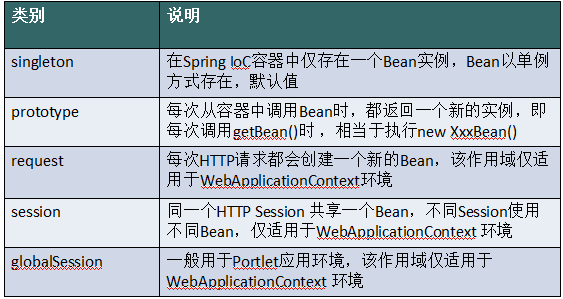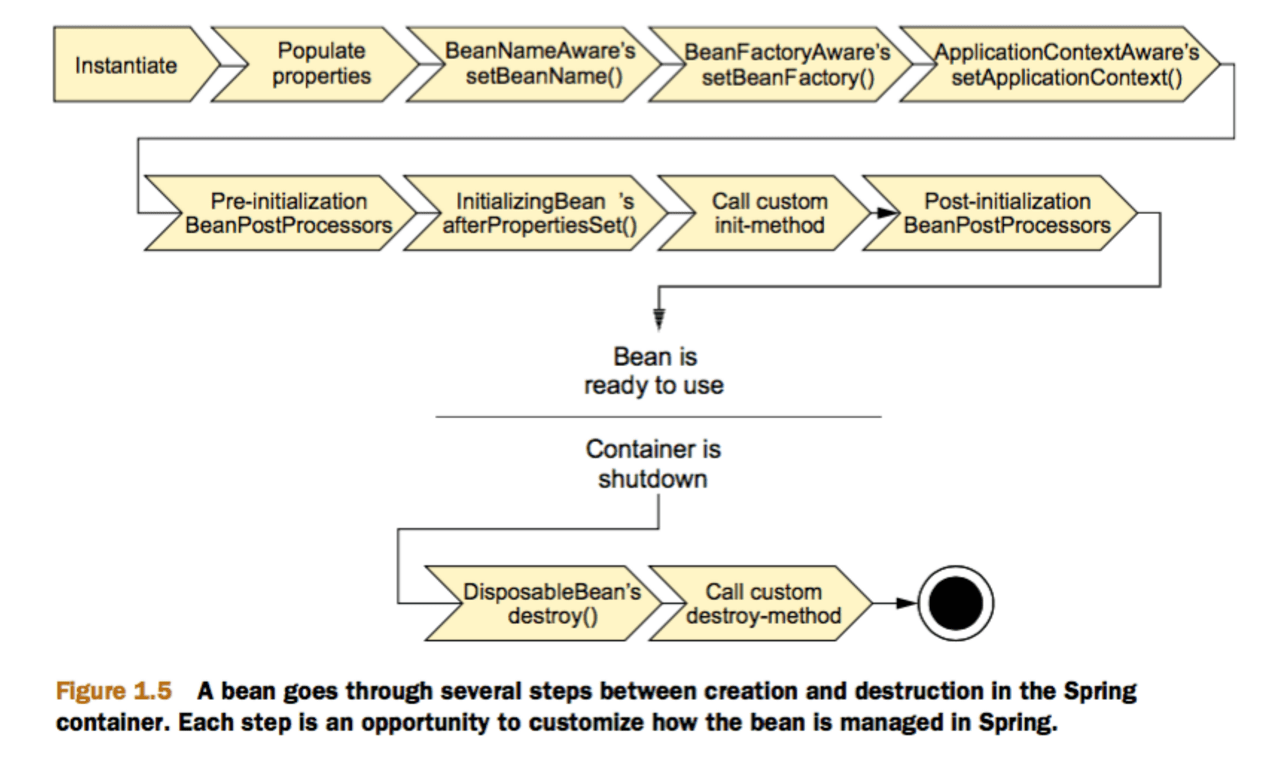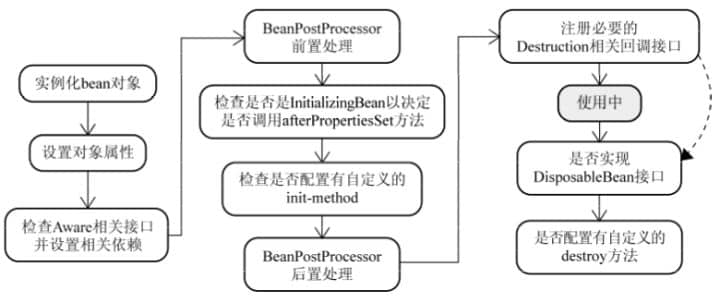在 Spring 中,那些组成应用程序的主体及由 Spring IOC 容器所管理的对象,被称之为 bean。简单地讲,bean 就是由 IOC 容器初始化、装配及管理的对象,除此之外,bean 就与应用程序中的其他对象没有什么区别了。而 bean 的定义以及 bean 相互间的依赖关系将通过配置元数据来描述。
Spring中的bean默认都是单例的,这些单例Bean在多线程程序下如何保证线程安全呢? 例如对于Web应用来说,Web容器对于每个用户请求都创建一个单独的Sevlet线程来处理请求,引入Spring框架之后,每个Action都是单例的,那么对于Spring托管的单例Service Bean,如何保证其安全呢? Spring的单例是基于BeanFactory也就是Spring容器的,单例Bean在此容器内只有一个,Java的单例是基于 JVM,每个 JVM 内只有一个实例。
在大多数情况下。单例 bean 是很理想的方案。不过,有时候你可能会发现你所使用的类是易变的,它们会保持一些状态,因此重用是不安全的。在这种情况下,将 class 声明为单例的就不是那么明智了。因为对象会被污染,稍后重用的时候会出现意想不到的问题。所以 Spring 定义了多种作用域的bean。
创建一个bean定义,其实质是用该bean定义对应的类来创建真正实例的“配方”。把bean定义看成一个配方很有意义,它与class很类似,只根据一张“处方”就可以创建多个实例。不仅可以控制注入到对象中的各种依赖和配置值,还可以控制该对象的作用域。这样可以灵活选择所建对象的作用域,而不必在Java Class级定义作用域。Spring Framework支持五种作用域,分别阐述如下表。
五种作用域中,request、session 和 global session 三种作用域仅在基于web的应用中使用(不必关心你所采用的是什么web应用框架),只能用在基于 web 的 Spring ApplicationContext 环境。
当一个 bean 的作用域为 singleton,那么Spring IoC容器中只会存在一个共享的 bean 实例,并且所有对 bean 的请求,只要 id 与该 bean 定义相匹配,则只会返回bean的同一实例。 singleton 是单例类型(对应于单例模式),就是在创建起容器时就同时自动创建了一个bean的对象,不管你是否使用,但我们可以指定Bean节点的 lazy-init=”true” 来延迟初始化bean,这时候,只有在第一次获取bean时才会初始化bean,即第一次请求该bean时才初始化。 每次获取到的对象都是同一个对象。注意,singleton 作用域是Spring中的缺省作用域。要在XML中将 bean 定义成 singleton ,可以这样配置:
<bean id="ServiceImpl" class="cn.csdn.service.ServiceImpl" scope="singleton">也可以通过 @Scope 注解(它可以显示指定bean的作用范围。)的方式
@Service
@Scope("singleton")
public class ServiceImpl{
}当一个bean的作用域为 prototype,表示一个 bean 定义对应多个对象实例。 prototype 作用域的 bean 会导致在每次对该 bean 请求(将其注入到另一个 bean 中,或者以程序的方式调用容器的 getBean() 方法**)时都会创建一个新的 bean 实例。prototype 是原型类型,它在我们创建容器的时候并没有实例化,而是当我们获取bean的时候才会去创建一个对象,而且我们每次获取到的对象都不是同一个对象。根据经验,对有状态的 bean 应该使用 prototype 作用域,而对无状态的 bean 则应该使用 singleton 作用域。** 在 XML 中将 bean 定义成 prototype ,可以这样配置:
<bean id="account" class="com.foo.DefaultAccount" scope="prototype"/>
或者
<bean id="account" class="com.foo.DefaultAccount" singleton="false"/> 通过 @Scope 注解的方式实现就不做演示了。
request只适用于Web程序,每一次 HTTP 请求都会产生一个新的bean,同时该bean仅在当前HTTP request内有效,当请求结束后,该对象的生命周期即告结束。 在 XML 中将 bean 定义成 request ,可以这样配置:
<bean id="loginAction" class=cn.csdn.LoginAction" scope="request"/>session只适用于Web程序,session 作用域表示该针对每一次 HTTP 请求都会产生一个新的 bean,同时该 bean 仅在当前 HTTP session 内有效.与request作用域一样,可以根据需要放心的更改所创建实例的内部状态,而别的 HTTP session 中根据 userPreferences 创建的实例,将不会看到这些特定于某个 HTTP session 的状态变化。当HTTP session最终被废弃的时候,在该HTTP session作用域内的bean也会被废弃掉。
<bean id="userPreferences" class="com.foo.UserPreferences" scope="session"/>global session 作用域类似于标准的 HTTP session 作用域,不过仅仅在基于 portlet 的 web 应用中才有意义。Portlet 规范定义了全局 Session 的概念,它被所有构成某个 portlet web 应用的各种不同的 portle t所共享。在global session 作用域中定义的 bean 被限定于全局portlet Session的生命周期范围内。
<bean id="user" class="com.foo.Preferences "scope="globalSession"/>Spring Bean是Spring应用中最最重要的部分了。所以来看看Spring容器在初始化一个bean的时候会做那些事情,顺序是怎样的,在容器关闭的时候,又会做哪些事情。
spring版本:4.2.3.RELEASE 鉴于Spring源码是用gradle构建的,我也决定舍弃我大maven,尝试下洪菊推荐过的gradle。运行beanLifeCycle模块下的junit test即可在控制台看到如下输出,可以清楚了解Spring容器在创建,初始化和销毁Bean的时候依次做了那些事情。
Spring容器初始化
=====================================
调用GiraffeService无参构造函数
GiraffeService中利用set方法设置属性值
调用setBeanName:: Bean Name defined in context=giraffeService
调用setBeanClassLoader,ClassLoader Name = sun.misc.Launcher$AppClassLoader
调用setBeanFactory,setBeanFactory:: giraffe bean singleton=true
调用setEnvironment
调用setResourceLoader:: Resource File Name=spring-beans.xml
调用setApplicationEventPublisher
调用setApplicationContext:: Bean Definition Names=[giraffeService, org.springframework.context.annotation.CommonAnnotationBeanPostProcessor#0, com.giraffe.spring.service.GiraffeServicePostProcessor#0]
执行BeanPostProcessor的postProcessBeforeInitialization方法,beanName=giraffeService
调用PostConstruct注解标注的方法
执行InitializingBean接口的afterPropertiesSet方法
执行配置的init-method
执行BeanPostProcessor的postProcessAfterInitialization方法,beanName=giraffeService
Spring容器初始化完毕
=====================================
从容器中获取Bean
giraffe Name=李光洙
=====================================
调用preDestroy注解标注的方法
执行DisposableBean接口的destroy方法
执行配置的destroy-method
Spring容器关闭
先来看看,Spring在Bean从创建到销毁的生命周期中可能做得事情。
有时我们需要在Bean属性值set好之后和Bean销毁之前做一些事情,比如检查Bean中某个属性是否被正常的设置好值了。Spring框架提供了多种方法让我们可以在Spring Bean的生命周期中执行initialization和pre-destroy方法。
1.实现InitializingBean和DisposableBean接口
这两个接口都只包含一个方法。通过实现InitializingBean接口的afterPropertiesSet()方法可以在Bean属性值设置好之后做一些操作,实现DisposableBean接口的destroy()方法可以在销毁Bean之前做一些操作。
例子如下:
public class GiraffeService implements InitializingBean,DisposableBean {
@Override
public void afterPropertiesSet() throws Exception {
System.out.println("执行InitializingBean接口的afterPropertiesSet方法");
}
@Override
public void destroy() throws Exception {
System.out.println("执行DisposableBean接口的destroy方法");
}
}这种方法比较简单,但是不建议使用。因为这样会将Bean的实现和Spring框架耦合在一起。
2.在bean的配置文件中指定init-method和destroy-method方法
Spring允许我们创建自己的 init 方法和 destroy 方法,只要在 Bean 的配置文件中指定 init-method 和 destroy-method 的值就可以在 Bean 初始化时和销毁之前执行一些操作。
例子如下:
public class GiraffeService {
//通过<bean>的destroy-method属性指定的销毁方法
public void destroyMethod() throws Exception {
System.out.println("执行配置的destroy-method");
}
//通过<bean>的init-method属性指定的初始化方法
public void initMethod() throws Exception {
System.out.println("执行配置的init-method");
}
}配置文件中的配置:
<bean name="giraffeService" class="com.giraffe.spring.service.GiraffeService" init-method="initMethod" destroy-method="destroyMethod">
</bean>
需要注意的是自定义的init-method和post-method方法可以抛异常但是不能有参数。
这种方式比较推荐,因为可以自己创建方法,无需将Bean的实现直接依赖于spring的框架。
3.使用@PostConstruct和@PreDestroy注解
除了xml配置的方式,Spring 也支持用 @PostConstruct和 @PreDestroy注解来指定 init 和 destroy 方法。这两个注解均在javax.annotation 包中。为了注解可以生效,需要在配置文件中定义org.springframework.context.annotation.CommonAnnotationBeanPostProcessor或context:annotation-config
例子如下:
public class GiraffeService {
@PostConstruct
public void initPostConstruct(){
System.out.println("执行PostConstruct注解标注的方法");
}
@PreDestroy
public void preDestroy(){
System.out.println("执行preDestroy注解标注的方法");
}
}配置文件:
<bean class="org.springframework.context.annotation.CommonAnnotationBeanPostProcessor" />
有些时候我们需要在 Bean 的初始化中使用 Spring 框架自身的一些对象来执行一些操作,比如获取 ServletContext 的一些参数,获取 ApplicaitionContext 中的 BeanDefinition 的名字,获取 Bean 在容器中的名字等等。为了让 Bean 可以获取到框架自身的一些对象,Spring 提供了一组名为*Aware的接口。
这些接口均继承于org.springframework.beans.factory.Aware标记接口,并提供一个将由 Bean 实现的set*方法,Spring通过基于setter的依赖注入方式使相应的对象可以被Bean使用。
网上说,这些接口是利用观察者模式实现的,类似于servlet listeners,目前还不明白,不过这也不在本文的讨论范围内。
介绍一些重要的Aware接口:
- ApplicationContextAware: 获得ApplicationContext对象,可以用来获取所有Bean definition的名字。
- BeanFactoryAware:获得BeanFactory对象,可以用来检测Bean的作用域。
- BeanNameAware:获得Bean在配置文件中定义的名字。
- ResourceLoaderAware:获得ResourceLoader对象,可以获得classpath中某个文件。
- ServletContextAware:在一个MVC应用中可以获取ServletContext对象,可以读取context中的参数。
- ServletConfigAware: 在一个MVC应用中可以获取ServletConfig对象,可以读取config中的参数。
public class GiraffeService implements ApplicationContextAware,
ApplicationEventPublisherAware, BeanClassLoaderAware, BeanFactoryAware,
BeanNameAware, EnvironmentAware, ImportAware, ResourceLoaderAware{
@Override
public void setBeanClassLoader(ClassLoader classLoader) {
System.out.println("执行setBeanClassLoader,ClassLoader Name = " + classLoader.getClass().getName());
}
@Override
public void setBeanFactory(BeanFactory beanFactory) throws BeansException {
System.out.println("执行setBeanFactory,setBeanFactory:: giraffe bean singleton=" + beanFactory.isSingleton("giraffeService"));
}
@Override
public void setBeanName(String s) {
System.out.println("执行setBeanName:: Bean Name defined in context="
+ s);
}
@Override
public void setApplicationContext(ApplicationContext applicationContext) throws BeansException {
System.out.println("执行setApplicationContext:: Bean Definition Names="
+ Arrays.toString(applicationContext.getBeanDefinitionNames()));
}
@Override
public void setApplicationEventPublisher(ApplicationEventPublisher applicationEventPublisher) {
System.out.println("执行setApplicationEventPublisher");
}
@Override
public void setEnvironment(Environment environment) {
System.out.println("执行setEnvironment");
}
@Override
public void setResourceLoader(ResourceLoader resourceLoader) {
Resource resource = resourceLoader.getResource("classpath:spring-beans.xml");
System.out.println("执行setResourceLoader:: Resource File Name="
+ resource.getFilename());
}
@Override
public void setImportMetadata(AnnotationMetadata annotationMetadata) {
System.out.println("执行setImportMetadata");
}
}上面的*Aware接口是针对某个实现这些接口的Bean定制初始化的过程, Spring同样可以针对容器中的所有Bean,或者某些Bean定制初始化过程,只需提供一个实现BeanPostProcessor接口的类即可。 该接口中包含两个方法,postProcessBeforeInitialization和postProcessAfterInitialization。 postProcessBeforeInitialization方法会在容器中的Bean初始化之前执行, postProcessAfterInitialization方法在容器中的Bean初始化之后执行。
例子如下:
public class CustomerBeanPostProcessor implements BeanPostProcessor {
@Override
public Object postProcessBeforeInitialization(Object bean, String beanName) throws BeansException {
System.out.println("执行BeanPostProcessor的postProcessBeforeInitialization方法,beanName=" + beanName);
return bean;
}
@Override
public Object postProcessAfterInitialization(Object bean, String beanName) throws BeansException {
System.out.println("执行BeanPostProcessor的postProcessAfterInitialization方法,beanName=" + beanName);
return bean;
}
}要将BeanPostProcessor的Bean像其他Bean一样定义在配置文件中
<bean class="com.giraffe.spring.service.CustomerBeanPostProcessor"/>所以。。。结合第一节控制台输出的内容,Spring Bean的生命周期是这样纸的:
- Bean容器找到配置文件中 Spring Bean 的定义。
- Bean容器利用Java Reflection API创建一个Bean的实例。
- 如果涉及到一些属性值 利用set方法设置一些属性值。
- 如果Bean实现了BeanNameAware接口,调用setBeanName()方法,传入Bean的名字。
- 如果Bean实现了BeanClassLoaderAware接口,调用setBeanClassLoader()方法,传入ClassLoader对象的实例。
- 如果Bean实现了BeanFactoryAware接口,调用setBeanFactory()方法,传入BeanFactory对象的实例。
- 与上面的类似,如果实现了其他*Aware接口,就调用相应的方法。
- 如果有和加载这个Bean的Spring容器相关的BeanPostProcessor对象,执行postProcessBeforeInitialization()方法
- 如果Bean实现了InitializingBean接口,执行afterPropertiesSet()方法。
- 如果Bean在配置文件中的定义包含init-method属性,执行指定的方法。
- 如果有和加载这个Bean的Spring容器相关的BeanPostProcessor对象,执行postProcessAfterInitialization()方法
- 当要销毁Bean的时候,如果Bean实现了DisposableBean接口,执行destroy()方法。
- 当要销毁Bean的时候,如果Bean在配置文件中的定义包含destroy-method属性,执行指定的方法。
用图表示一下(图来源:http://www.jianshu.com/p/d00539babca5):
与之比较类似的中文版本:
其实很多时候我们并不会真的去实现上面说描述的那些接口,那么下面我们就除去那些接口,针对bean的单例和非单例来描述下bean的生命周期:
当scope=”singleton”,即默认情况下,会在启动容器时(即实例化容器时)时实例化。但我们可以指定Bean节点的lazy-init=”true”来延迟初始化bean,这时候,只有在第一次获取bean时才会初始化bean,即第一次请求该bean时才初始化。如下配置:
<bean id="ServiceImpl" class="cn.csdn.service.ServiceImpl" lazy-init="true"/> 如果想对所有的默认单例bean都应用延迟初始化,可以在根节点beans设置default-lazy-init属性为true,如下所示:
<beans default-lazy-init="true" …>默认情况下,Spring 在读取 xml 文件的时候,就会创建对象。在创建对象的时候先调用构造器,然后调用 init-method 属性值中所指定的方法。对象在被销毁的时候,会调用 destroy-method 属性值中所指定的方法(例如调用Container.destroy()方法的时候)。写一个测试类,代码如下:
public class LifeBean {
private String name;
public LifeBean(){
System.out.println("LifeBean()构造函数");
}
public String getName() {
return name;
}
public void setName(String name) {
System.out.println("setName()");
this.name = name;
}
public void init(){
System.out.println("this is init of lifeBean");
}
public void destory(){
System.out.println("this is destory of lifeBean " + this);
}
}life.xml配置如下:
<bean id="life_singleton" class="com.bean.LifeBean" scope="singleton"
init-method="init" destroy-method="destory" lazy-init="true"/>测试代码:
public class LifeTest {
@Test
public void test() {
AbstractApplicationContext container =
new ClassPathXmlApplicationContext("life.xml");
LifeBean life1 = (LifeBean)container.getBean("life");
System.out.println(life1);
container.close();
}
}运行结果:
LifeBean()构造函数
this is init of lifeBean
com.bean.LifeBean@573f2bb1
……
this is destory of lifeBean com.bean.LifeBean@573f2bb1
当scope=”prototype”时,容器也会延迟初始化 bean,Spring 读取xml 文件的时候,并不会立刻创建对象,而是在第一次请求该 bean 时才初始化(如调用getBean方法时)。在第一次请求每一个 prototype 的bean 时,Spring容器都会调用其构造器创建这个对象,然后调用init-method属性值中所指定的方法。对象销毁的时候,Spring 容器不会帮我们调用任何方法,因为是非单例,这个类型的对象有很多个,Spring容器一旦把这个对象交给你之后,就不再管理这个对象了。
为了测试prototype bean的生命周期life.xml配置如下:
<bean id="life_prototype" class="com.bean.LifeBean" scope="prototype" init-method="init" destroy-method="destory"/>测试程序:
public class LifeTest {
@Test
public void test() {
AbstractApplicationContext container = new ClassPathXmlApplicationContext("life.xml");
LifeBean life1 = (LifeBean)container.getBean("life_singleton");
System.out.println(life1);
LifeBean life3 = (LifeBean)container.getBean("life_prototype");
System.out.println(life3);
container.close();
}
}运行结果:
LifeBean()构造函数
this is init of lifeBean
com.bean.LifeBean@573f2bb1
LifeBean()构造函数
this is init of lifeBean
com.bean.LifeBean@5ae9a829
……
this is destory of lifeBean com.bean.LifeBean@573f2bb1
可以发现,对于作用域为 prototype 的 bean ,其destroy方法并没有被调用。如果 bean 的 scope 设为prototype时,当容器关闭时,destroy 方法不会被调用。对于 prototype 作用域的 bean,有一点非常重要,那就是 Spring不能对一个 prototype bean 的整个生命周期负责:容器在初始化、配置、装饰或者是装配完一个prototype实例后,将它交给客户端,随后就对该prototype实例不闻不问了。 不管何种作用域,容器都会调用所有对象的初始化生命周期回调方法。但对prototype而言,任何配置好的析构生命周期回调方法都将不会被调用。清除prototype作用域的对象并释放任何prototype bean所持有的昂贵资源,都是客户端代码的职责(让Spring容器释放被prototype作用域bean占用资源的一种可行方式是,通过使用bean的后置处理器,该处理器持有要被清除的bean的引用)。谈及prototype作用域的bean时,在某些方面你可以将Spring容器的角色看作是Java new操作的替代者,任何迟于该时间点的生命周期事宜都得交由客户端来处理。
Spring 容器可以管理 singleton 作用域下 bean 的生命周期,在此作用域下,Spring 能够精确地知道bean何时被创建,何时初始化完成,以及何时被销毁。而对于 prototype 作用域的bean,Spring只负责创建,当容器创建了 bean 的实例后,bean 的实例就交给了客户端的代码管理,Spring容器将不再跟踪其生命周期,并且不会管理那些被配置成prototype作用域的bean的生命周期。
本文的完成结合了下面两篇文章,并做了相应修改:
- https://blog.csdn.net/fuzhongmin05/article/details/73389779
- https://yemengying.com/2016/07/14/spring-bean-life-cycle/
由于本文非本人独立原创,所以未声明为原创!在此说明!


